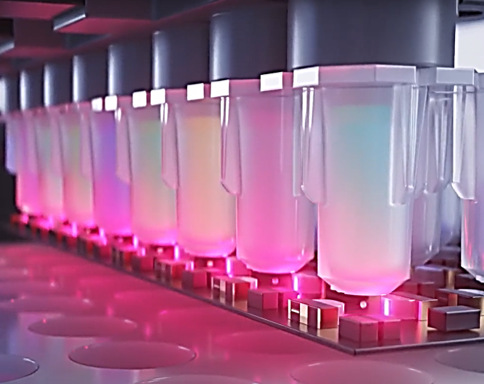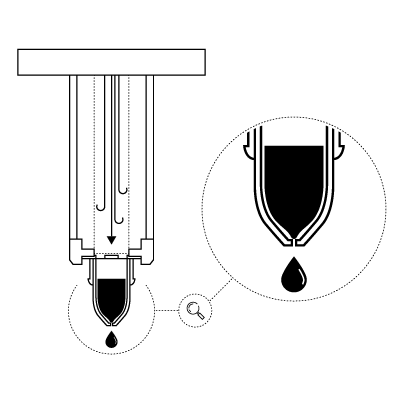Next-generation sequencing (NGS) is a massively parallel sequencing technology that holds huge promise for genomic research, rare disease diagnostics, and personalized medicine1. Despite its potential, NGS comes with considerable challenges, many of which are associated with the error-prone, lengthy, and cost-inefficient NGS library preparation stage.
However, these challenges can be overcome by integrating advanced automated liquid handling into library preparation pipelines. The I.DOT Liquid Handler represents a game changer for NGS library preparation workflows (Fig. 1). Here, we explore how the I.DOT Non-contact Dispenser can streamline processes to save time and money in NGS library preparation.

Figure 1. Workflow schematic showing where the I.DOT Liquid Handler and G.PURE NGS Clean-up Device fit into the NGS library preparation workflow.

Saving Money with the I.DOT
While significantly cheaper than traditional Sanger sequencing, NGS is still relatively expensive when all costs are considered2, limiting its use in many labs1. The main costs associated with NGS library preparation are equipment costs, labor costs, and reagent costs3, all of which can be reduced considerably by automating up to 80% of the library preparation process.
Reducing Reagent Costs
Minimizing dead volume is crucial in reducing reagent use, especially when dealing with expensive reagents. Miniaturizing reaction setups through the use of microplates or microfluidic systems significantly decreases the required volume of reagents and samples, thus reducing dead volumes and associated costs4.
The I.DOT Non-contact Dispenser facilitates miniaturization, supporting accurate dispensing volumes as low as 8 nL through volume verification technology and requiring a dead volume of only 1 µL (Fig. 2). With the I.DOT users can scale NGS reaction volumes as low as one-tenth of the manufacturer’s recommended SOP without compromising data quality. This reduces costs significantly and is especially useful when working with precious, unreadily available samples like patient samples5.

Figure 2. DropDetection enables the detection and counting of every droplet released during a dispensing run, ensuring robust and accurate dispensing of low liquid volumes.
Reducing Labor Costs
Automating the NGS library preparation workflow significantly enhances experiment throughput. This automation allows multiple samples to be processed simultaneously with minimal manual intervention, effectively decreasing the number of experiments that need to be performed manually. This reduction in hands-on time leads to considerable savings in labor costs, making it an economically beneficial investment.
Automation has also been shown to reduce the risk of human error and contamination, which can lead to costly and time-consuming repeats of experiments6. The precision and reproducibility offered by automated systems ensure high-quality data, reducing the need for complex data filtering and unnecessary repeats and lowering labor costs7.
Reducing Equipment Costs
Given the initial expenses associated with automated devices, many people believe that automating workflows leads to higher equipment costs. However, when estimating NGS costs, it is important to consider many factors, including instrument purchase, cost per sample (consumables, reagents, and labor inclusive), data analysis and storage, and training costs2. When this is evaluated fully, lab managers frequently find that the long-term benefits far outweigh the initial equipment costs, primarily through enhanced operational efficiency, reduced labor costs, and lower consumable expenditures. The I.DOT Non-contact Dispenser enables tipless reactions, which saves money on consumables while also supporting labs in sustainability efforts, which are becoming increasingly important requirements of lab operations8,9.
Saving Time with the I.DOT
In addition to its high costs, NGS library preparation is also highly time-consuming. Manual library preparation requires up to eight hours of hands-on time and can take up to a full day for DNA libraries and two days for mRNA libraries. Aside from the labor costs incurred, this is highly inefficient, and the potential for error increases exponentially with increasing time and steps. Automating processes can significantly reduce turnaround times by increasing throughput, reducing manual steps, and minimizing unnecessary replicates10.
Increased Throughput
Automated liquid handling facilitates a significant increase in the throughput of NGS library preparation by enabling batch sample processing. This means that multiple samples can be processed simultaneously rather than sequentially, a common limitation in manual or less advanced automated systems11. Liquid dispensing and cleaning with automated systems is also markedly faster than traditional methods. This rapid processing capability not only speeds up the entire workflow but also minimizes the downtime that typically occurs between steps in manual handling, resulting in a substantial reduction in NGS library preparation turnaround times.
Fewer Manual Steps & Repeated Experiments
Automation with the I.DOT system drastically reduces the need for manual intervention during the NGS library preparation process. In traditional library prep, manual steps not only waste time but also introduce variability and errors, such as pipetting inaccuracies, which are avoided with automated liquid handling.
Additionally, the I.DOT’s non-contact dispensing technology plays a crucial role in preventing cross-contamination between samples (Fig. 3), which represents a significant concern in NGS workflows as it can compromise the integrity of the sequencing data, invalidating data and requiring re-runs. With automation, integrity is maintained, meaning that each sample is more likely to be used as a valid data point, thus reducing the frequency and need for costly and time-consuming repeats due to errors or contamination6.

Figure 3. The I.DOT employs a non-contact dispensing mechanism, which eliminates the risk of cross-contamination while also supporting tipless dispensing.
Conclusion
Integrating advanced automation technologies into NGS library preparation workflows presents an effective solution to cost and time efficiency challenges. By minimizing manual interventions and reducing the consumption of valuable reagents and labor, automation enhances operational efficiencies and lowers the overall costs associated with NGS. It not only expedites the library preparation process through increased throughput and reduced manual steps but also mitigates the risks of error and cross-contamination. This highlights the cost-effectiveness of investments in automation technology, yielding significant long-term benefits in NGS workflows.
Ready to streamline your NGS library preparation and free up resources for what matters most? The I.DOT Liquid Handler is your key to efficiency and cost-effectiveness. Book a demo today and see for yourself!
References
- Grada A, Weinbrecht K. Next-Generation Sequencing: Methodology and Application. J Invest Dermatol. 2013;133(8):1-4. doi:10.1038/jid.2013.248
- Schwarze K, Buchanan J, Fermont JM, et al. The complete costs of genome sequencing: a microcosting study in cancer and rare diseases from a single center in the United Kingdom. Genet Med. 2020;22(1):85-94. doi:10.1038/s41436-019-0618-7
- Hess JF, Kohl TA, Kotrová M, et al. Library preparation for next generation sequencing: A review of automation strategies. Biotechnol Adv. 2020;41:107537. doi:10.1016/j.biotechadv.2020.107537
- Suckling L, McFarlane C, Sawyer C, et al. Miniaturisation of high-throughput plasmid DNA library preparation for next-generation sequencing using multifactorial optimisation. Synth Syst Biotechnol. 2019;4(1):57-66. doi:10.1016/j.synbio.2019.01.002
- Dahui Q. Next-generation sequencing and its clinical application. Cancer Biol Med. 2019;16(1):4-10. doi:10.20892/j.issn.2095-3941.2018.0055
- Torres-Acosta MA, Lye GJ, Dikicioglu D. Automated liquid-handling operations for robust, resilient, and efficient bio-based laboratory practices. Biochem Eng J. 2022;188:108713. doi:10.1016/j.bej.2022.108713
- Melo MR, Clark S, Barrio D. Miniaturization and globalization of clinical laboratory activities. cclm. 2011;49(4):581-586. doi:10.1515/CCLM.2011.092
- Bistulfi G. Reduce, reuse and recycle lab waste. Nature. 2013;502(7470):170-170. doi:10.1038/502170a
- Alves J, Sargison FA, Stawarz H, et al. A case report: insights into reducing plastic waste in a microbiology laboratory. Access Microbiol. 2021;3(3). doi:10.1099/acmi.0.000173
- Socea JN, Stone VN, Qian X, Gibbs PL, Levinson KJ. Implementing laboratory automation for next-generation sequencing: benefits and challenges for library preparation. Front Public Health. 2023;11:1195581. doi:10.3389/fpubh.2023.1195581
- O’Neill MD. Increasing Throughput with Automated Liquid Handling. Genet Eng Biotechnol News. 2012;32(12):18-21. doi:10.1089/gen.32.12.06
